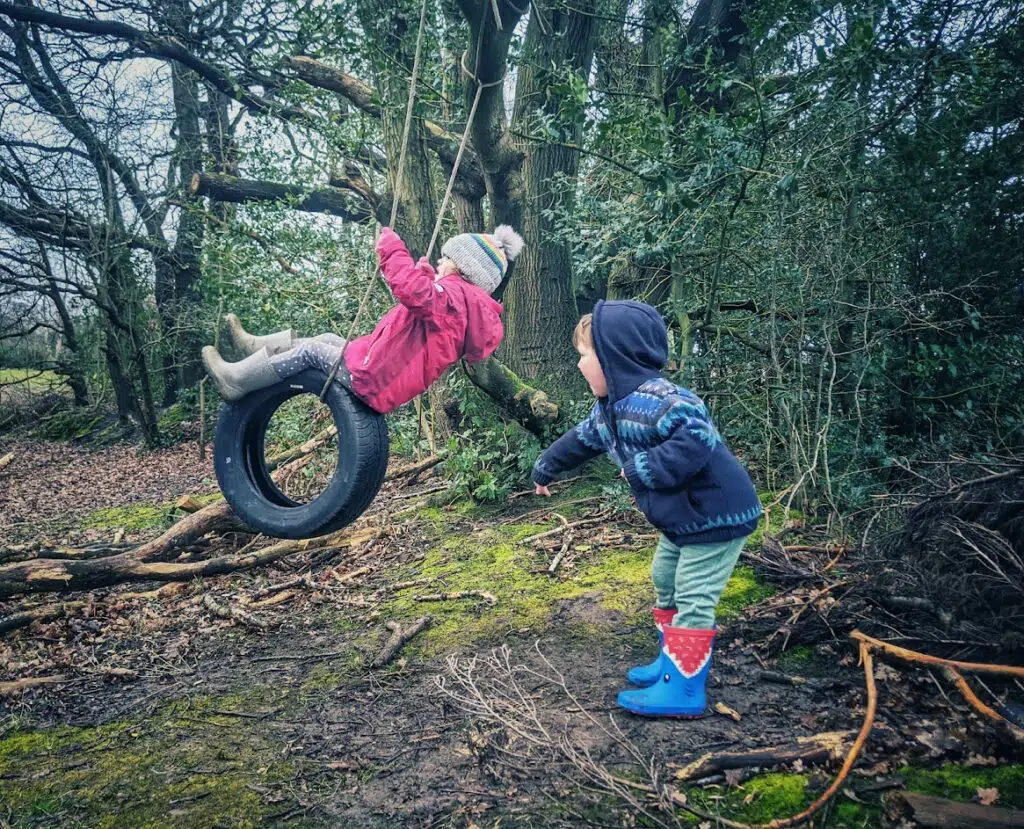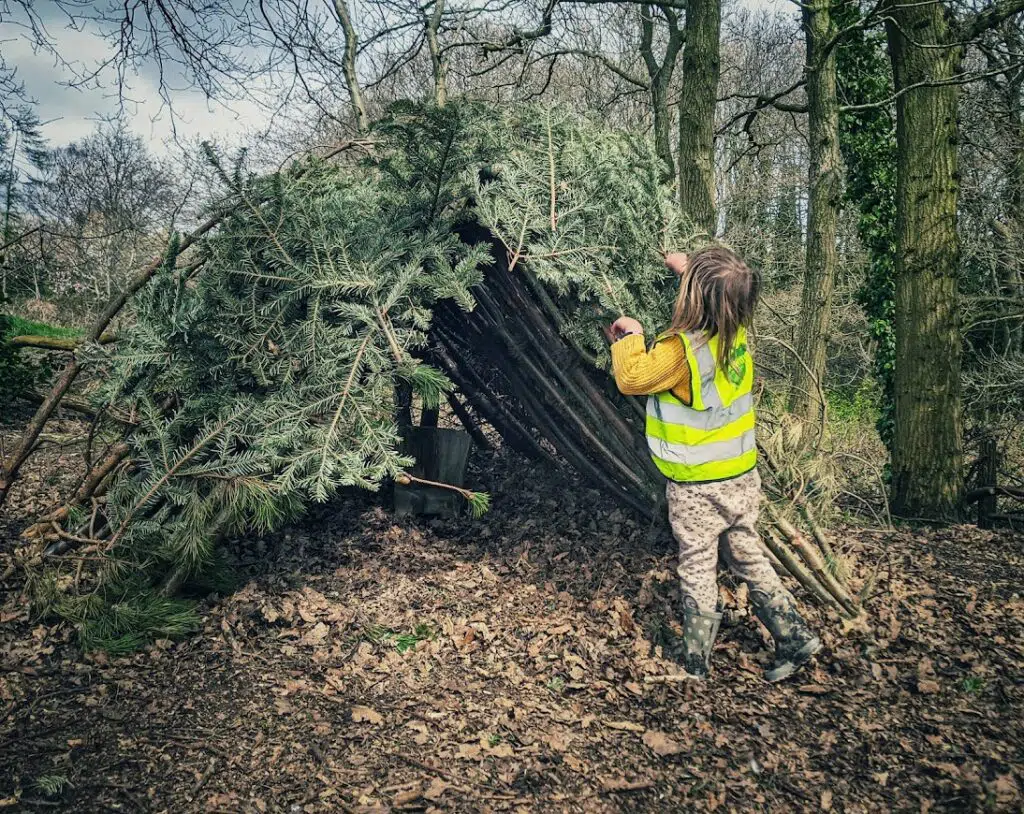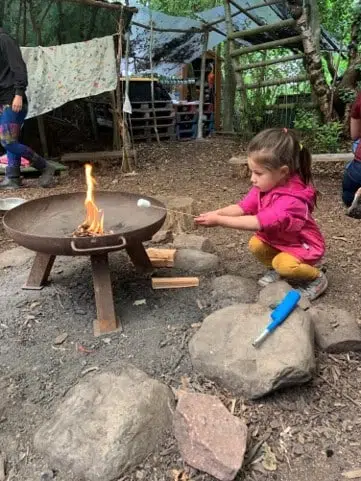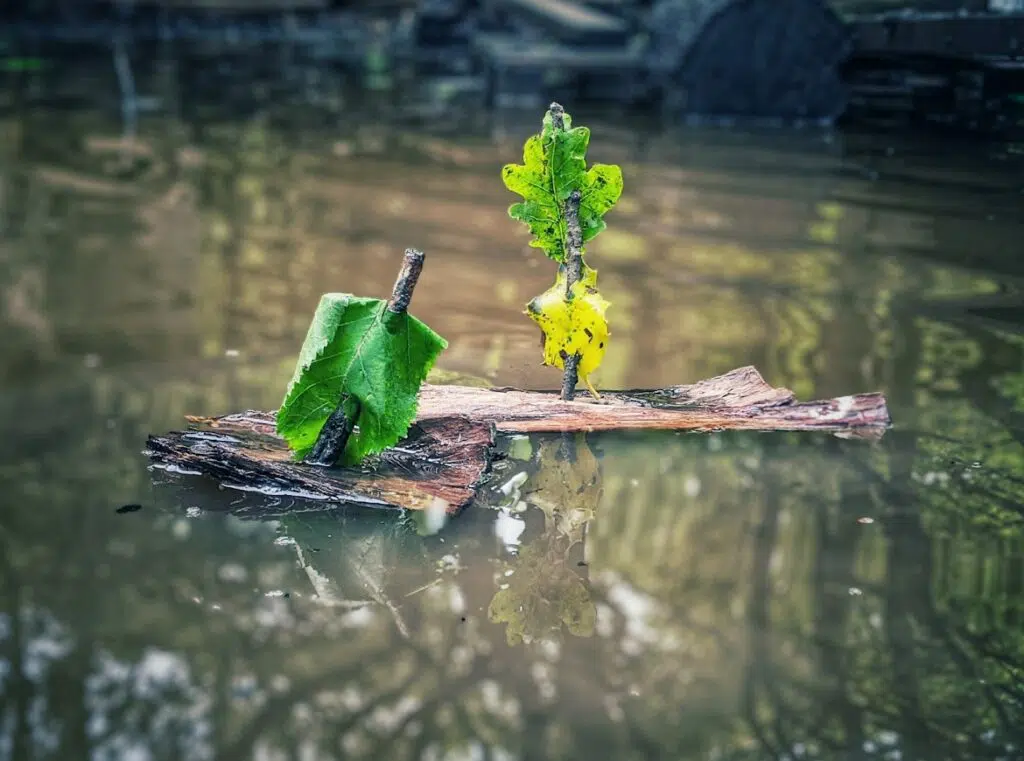Winter in a Forest school can be beautiful and as long as everyone is wrapped up warm (and that includes the adults too) it can provide plenty of opportunities for awe and wonder. Just imagine…
Silvery cobwebs covered in twinkling frost
The first untouched blanket of soft snow
Exposed birds nests at the top of bare trees
The warmth and smell of a campfire.
I’ve run forest school sessions in the heart of winter for many years, and in this post, I’m going to talk you through the ultimate 10 forest school winter activities.

1. Build A Den/Shelter
Building a shelter or a den is a great physical challenge to keep warm in the chillier weather.
With younger children, a lovely way to introduce den or shelter building is to ask them to build a home for a woodland animal, for example, a hedgehog.
If possible, provide the children with a toy hedgehog or a similar woodland animal. A great place to find woodland soft toys is in charity shops.
For a small amount of money, you can usually build up a lovely collection of woodland creatures to keep the children interested in this activity such as:
Hedgehogs
Mice
Squirrels
Foxes
Badgers
and frogs
In winter, the Forest floor is littered with small twigs and branches. Encourage the children to choose a safe and sheltered place in the Forest site for their creature’s home.
Then it’s time to get busy!
Ask the children to run and collect as many sticks as they can to build a den around their creature. You could add wheelbarrows for the children to collect and transport their sticks if you wanted to.
Remember to leave a little door so their animal can get in and out.
When they are satisfied with their shelter, ask the children to look for materials to decorate their den or try to find ways to make it water-tight.
When everyone is happy with their den, visit each one in turn and talk about how the animals will enjoy being warm and safe, protected from the winter weather.

2. Collecting Firewood
Keeping a good stock of kindle and firewood for the campfire is a really important job in the Winter months.
Model to the children how to scour the forest floor to collect small twigs for kindling to help light the fire. Ask the children to transport the sticks and twigs.
Provide different options like wheelbarrows, ropes, tarpaulins, and sacks to transport the firewood to a central point. You could also encourage them to work together to drag and transport larger branches to a firewood pile.
3. Healthy Camp Fire Recipes
Sitting around a campfire in the forest and sharing some warm food together is a magical moment and one that children will remember for years to come.
It’s sometimes surprising how many children suddenly forget to be fussy eaters when they’ve been out in the fresh air, taking part in physical activities. (Source)
Here are a couple of tried and tested recipes:
Leek and Potato soup.
(Prepare it in your setting with the children the day before).
Peel and chop 2 large potatoes and 2 leeks.
Boil them in a pan with a stock cube and a pinch of salt and pepper.
When the vegetables are soft blend them into a soup and add a dash of milk or cream.
Heat up the soup in a pan on the campfire and enjoy it in a mug with a wedge of fresh bread.
Healthy Tuna Couscous
(Prepare it in your setting with the children the day before)
Prepare your couscous according to the packet instructions. I like to add a stock cube to the hot water.
Add a tin of tuna (drained) and a small tin of sweetcorn, chopped cherry tomatoes, and chopped cucumber. Mix everything together well. You can add chopped herbs too if you want to.
Heat it up gently in a pan on the camp fire with a little extra water and spoon into bowls.
Along with these healthy recipes, just being outside in the cold has health benefits as demonstrated by research. (Source)

4. Winter Bird Watch
It’s important to give children space and time to pause and think.
Winter is a perfect time for bird watching. There are still plenty of Winter birds around throughout the year and with the branches bare, birds and their nests are often easier to spot in the Winter.
Begin this activity by getting all the children together. They can either sit down with you or if they are in full waterproofs, you can ask them to lie on their backs and look up at the Winter sky.
A lovely way to draw the children’s attention to the birds is with a low-sounding instrument such as a wooden whistle. Try blowing it gently and leaving a long pause.
Ask the children to watch the sky as you call the birds.
You could provide clipboards with pictures of winter birds such as:
- Robin
- Chaffinch
- Woodcock
- Waxwing
- Starling
- Blackbirds
Talk to the children about how some birds fly away to warmer countries for the Winter, and some stay at home. Look out for ground feeders like blackbirds and birds that like to feed higher up, like robins.
5. Feed The Birds
Our birds sometimes need a little help to survive in the winter.
Talk to the children about providing water and food for our birds. Encourage their own ideas.
I like to introduce them to pine cone feeders.
Ask the children to collect pine cones from the forest floor. (Smaller cones work best for this activity)
Help the children to tie some garden string or twine around the cones.
Mix together some porridge oats, cornmeal, and peanut butter. (A little bit of coconut oil can help if the mixture is a bit too sticky).
Now the fun starts. Ask the children to squeeze and mix the ingredients together with their fingers and then spread the mixture into the pinecone. Keep working around the cone until all the gaps are filled.
Finally, fill a bowl with birdseed and roll the pine cones in the seed until they are covered all over.
Ask the children to find places in the forest to hang the bird feeders in the trees and bushes.
6. Wonderful Winter Art
It’s important to give children opportunities to appreciate how the forest changes in Winter. A scavenger hunt will be completely different to the Spring and Summer, but that is really the point.
Go on a scavenger hunt and collect pine cones, acorns, conkers, and their cases, dried grasses, and seed pods, rocks, twigs, anything you and the children find interesting. Spread your Winter treasures onto a tarpaulin and talk about your finds. Look out for:
Natural patterns
Beautiful colors
Interesting shapes
Different sizes
Even without the colours of springtime flowers, there will still be plenty of interesting things to discover and lots to talk about.
Arrange the treasures to make a wonderful winter collage. If you want inspiration, Andy Goldsworthy is a brilliant place to start. Try the video below as a good introduction.
7. Listening Walk
This is a good activity for developing listening and concentration.
Try to find a number of listening jewels. These could be glass pebbles, costume jewellery, crystals, or anything you can find that looks a little bit special and that a child can hold comfortably in their hand.
Charity shops are a good place to find them. Try to provide one per child.
Explain to the children that you are going on a listening walk. Stop in various places around the forest and hand the children the listening jewel.
Try to create a bit of magic around this. I like to use a special velvet bag and whisper each child’s name as I take their jewel out of the bag.
Explain that when they are holding the jewel, they must listen extra carefully.
This activity creates lovely moments of stillness where the children stop and focus. Allow a few minutes of listening before anyone speaks, then talk about what you heard.
8. Magic Moment Puddles
It’s brilliant if you already have natural puddles in your outdoor site.
Young children will have plenty of fun splashing and jumping over them. But why stop there when you can extend the fun?
Try adding some washing up liquid to a puddles, give it a good stir with a stick and encourage the children to splash about in their wellies to make the biggest bubbles they possibly can.
When the bubbles start to burst and fade away, see if they can empty a puddle by jumping.
Count how many jumps it takes to empty a puddle – This is great for encouraging physical skills. Try to encourage jumping with 2 feet together if they can. They could also try to splash the water as high as they can!
Try adding a dash of food colouring or power paint to puddles. Use sticks to mix. This is a lovely way to introduce colour mixing.
Another beautiful and simple activity are these spectacular natural boats:

Boats can be as simple as getting leaves or bits of bark and floating them across the puddle.
The ones in this picture have been crafted by preschool children using a hand drill to cut a hole in pieces of wood, and then putting a stick into the hole as a sail.
9. Transport The Water
A forest site is a great place to encourage natural problem solving. Provide the children with loose parts such as:
different sized containers
pots and pans
buckets
tubes / pipes
sieves scoops and ladles.
wheelbarrows
Ask the children to see if they can move the puddles from one area to another.
10. Reflect And Have Fun!!
You only get one chance to be a young child! That’s why we need to seize the day sometimes and go with the moment.
When the snow comes down, get out there and have fun!
Show the children how lie down and kick up snow angels (lie on your back and wave your arms and legs up and down to leave an angel print in the snow).
Build the biggest snowman you can together or find sticks and write your names in the snow.
If a rainbow appears in the Winter sky, take the time to pause and wonder about it.
Ask the children to tell you their Winter Wishes. A lovely time to do this is sitting around the campfire.
If they could wish for anything in the world what would they wish for themselves, for their friends, and for the creatures in the Forest?
You could light a candle if you want to create more atmosphere.
Remember, having fun is essential to children’s well-being.
